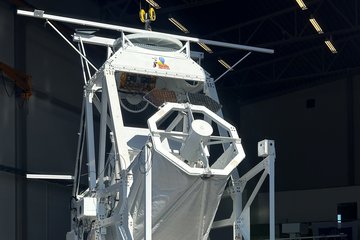All genres
1.
Journal Article
The MODEST catalog of depth-dependent spatially coupled inversions of sunspots observed by Hinode/SOT-SP. Astronomy and Astrophysics 687, p. A218 (2024)
2.
Journal Article
Evolution of solar surface inflows around emerging active regions. Astronomy and Astrophysics 652, A148 (2021)
3.
Journal Article
Similarities of magnetoconvection in the umbra and in the penumbra of sunspots. Astronomy and Astrophysics 655, A61 (2021)
4.
Journal Article
Connecting the Wilson depression to the magnetic field of sunspots. Astronomy and Astrophysics 635, A202 (2020)
5.
Journal Article
No universal connection between the vertical magnetic field and the umbra-penumbra boundary in sunspots. Astronomy and Astrophysics 639, A106 (2020)
6.
Journal Article
Exploring the latitude and depth dependence of solar Rossby waves using ring-diagram analysis. Astronomy and Astrophysics 634, A44 (2020)
7.
Journal Article
The Polarimetric and Helioseismic Imager on Solar Orbiter. Astronomy and Astrophysics 642, A11 (2020)
8.
Journal Article
Global-scale equatorial Rossby waves as an essential component of solar internal dynamics. Nature astronomy 2, pp. 568 - 573 (2018)
9.
Journal Article
Measuring the Wilson depression of sunspots using the divergence-free condition of the magnetic field vector. Astronomy and Astrophysics 619, A42 (2018)
10.
Journal Article
Measuring solar active region inflows with local correlation tracking of granulation. Astronomy and Astrophysics 606, A28 (2017)
11.
Journal Article
A low upper limit on the subsurface rise speed of solar active regions. Science Advances 2, p. e1600557 - e1600557 (2016)
12.
Journal Article
Data compression for local correlation tracking of solar granulation. Astronomy and Astrophysics 587, A9 (2016)
13.
Journal Article
The shrinking Sun: a systematic error in local correlation tracking of solar granulation. Astronomy and Astrophysics 590, A130 (2016)
14.
Journal Article
Image compression in local helioseismology. Astronomy and Astrophysics 571, A42 (2014)
15.
Talk
Relating the magnetic field strength with the umbra-penumbra boundary in sunspots. SolarPolarization Workshop 9, Göttingen, Germany (2019)
16.
Talk
On the latitude dependence of Rossby waves in the Sun. 234th Meeting of the American Astronomical Society, St. Louis, USA (2019)
17.
Talk
Exploring the latitude and depth dependence of solar Rossby waves. 2nd Max Planck Partner Group Workshop on Solar Physics, Mumbai, India (2019)
18.
Talk
A new method for measuring the Wilson depression of sunspots. Hinode - 12 The many Suns, Granada, Spain (2018)
19.
Talk
Rossby waves on the Sun. 15th European Solar Physics Meeting, Budapest, Hungary (2017)
20.
Talk
Helioseismology with the Solar Orbiter mission. Seismology of the Sun and the Distant Stars 2016, Angra do Heroísmo, Portugal (2016)











